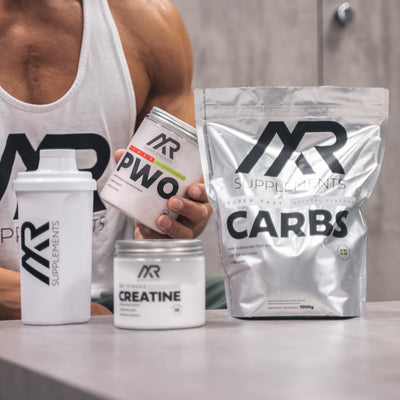Welcome to a world where strength and muscle growth are the focus. This guide is tailored for beginners and aims to give you a solid foundation in your training journey. We'll explore everything from training frequency to the importance of recovery.
Training Frequency and Volume
Training each muscle group 2-3 times per week is recommended, as this often leads to increased weekly volume, which is beneficial for both strength and hypertrophy. However, it is critical to avoid overtraining, which can occur with too high a training frequency, such as 3-7 times per muscle group per week.
Periodization and Individual Differences
Periodization, which involves varying training frequency and volume over time, is crucial to avoid overtraining and stimulate continuous progress. Training should also be tailored to individual conditions and response to training, as what works for one person may not necessarily work for another.
Hypertrophy training
Hypertrophy training, which aims to maximize muscle growth, requires a high training volume. This usually means 3-6 sets per exercise and 6-12 repetitions per set. Shorter rest periods of about 60-90 seconds between sets are recommended to maximize muscle growth. The frequency should be to train each major muscle group 2-3 times per week.
An example of a weekly schedule for hypertrophy training with 5 sessions might look like this:
Day 1: Chest and triceps (e.g. bench press, dumbbell press, triceps pushdowns - 4 sets x 8-12 reps)
Day 2: Back and biceps (e.g. pull-ups, rowing, biceps curls - 4 sets x 8-12 reps)
Day 3: Legs (e.g. squats, lunges, leg press - 4 sets x 8-12 reps)
Day 4: Shoulders and abs (e.g. shoulder press, lateral raise, crunches - 4 sets x 8-12 reps)
Day 5: Full body workout (combination of exercises for all major muscle groups - 3 sets x 8-12 reps)
Days 6 and 7 : Rest This schedule provides a balanced weekly plan and ensures that each major muscle group is effectively trained. Remember to adapt the plan to your own needs and recovery ability.
To enhance your training, consider Get Strong Creatine. It is a 100% Creatine Monohydrate that improves strength, endurance and muscle volume. It is well-studied and increases physical performance, making it suitable for a variety of sports.

Powerlifting is a discipline that focuses on building maximum strength, primarily through the three basic exercises: squat, bench press, and deadlift. This form of training requires careful planning and attention to recovery, as it places high demands on the body.
Keep the following in mind when training for powerlifting:
Sets and Reps : When it comes to sets and reps in powerlifting, it is common to train with a lower volume but higher intensity compared to hypertrophy training. This usually means fewer repetitions (usually between 1 and 6) but with heavier weights. The goal is to maximize strength rather than focusing on muscle growth. By limiting the number of repetitions, you can concentrate on lifting heavier weights, which is critical for building maximum strength.
Rest periods : Rest periods in powerlifting are longer than in traditional strength training, often between 3 to 5 minutes between each set. These longer rest periods are crucial to ensuring full recovery of the muscles and central nervous system. This allows you to maintain high intensity and power throughout the workout, which is crucial to the effectiveness of powerlifting.
5-Day Program Layout : A 5-day powerlifting training program might look like this:
Day 1 : Squats - Focus on heavy lifting, 4 sets x 3-5 reps
Day 2 : Bench Press - Focus on technique and strength, 4 sets x 3-5 reps
Day 3 : Rest or light active recovery
Day 4 : Deadlifts - Focus on heavy lifts, 4 sets x 3-5 reps
Day 5 : Assistance exercises - Includes exercises like front bends and military presses to strengthen supporting muscles, varying the number of sets and reps
Days 6 and 7 : Rest or active recovery
It is important to note that these guidelines are general and should be adjusted individually. As a beginner, it may be wise to start with lighter weights and fewer sets to gradually build your strength and technique, before increasing the intensity of your training.
Recovery
Recovery is a vital part of any training program, especially in strength training and powerlifting. Effective recovery is crucial for muscle repair, strength gains, and reducing the risk of injury. Here are some tips for optimal recovery:
-
Adequate Sleep: Sleep is perhaps the most important aspect of recovery. Aim for 7-9 hours of quality sleep each night. During sleep, important repair and rebuilding processes occur in the body.
-
Nutrition and Hydration: A balanced intake of proteins, carbohydrates and fats is important for repairing and building muscles. Protein intake is particularly important, and it is recommended to be around 2-3 grams per kg of body weight for optimal muscle repair and growth. Don't forget to stay well hydrated too. A fluid intake of at least 2-3 liters a day is crucial for the overall functioning of the body and helps optimize recovery.
-
Active Recovery: Light physical activity such as walking or yoga can promote blood circulation and thus speed up recovery.
-
Stretching and Mobility Training: This can help reduce muscle stiffness and promote mobility.
Overtraining
Overtraining occurs when the intensity and volume of training exceeds the body's ability to recover. Signs of overtraining include extreme fatigue, decreased performance, sleep problems, and increased risk of injury. To avoid this, it is important to balance hard training with adequate rest, nutrition, and sleep. Listening to your body's signals and adjusting your training load after recovery is also crucial. A well-balanced diet rich in nutrients, adequate protein intake, and sufficient hydration play a major role in preventing overtraining.
In our constant pursuit of improved training results and faster recovery, it is important to not only focus on the training itself, but also on what we consume before, during and after the workout.
Super EAA for Increased Protein Synthesis and Faster Recovery
Super EAA from AR Supplements is an advanced amino acid product that offers a complete composition of essential amino acids.
Here are some benefits of Super EAA:
- Increased Protein Synthesis: EAA (Essential Amino Acids) are known to effectively increase protein synthesis, which is important for optimal muscle building and repair.
- Improved Recovery: With Super EAA you can expect faster and more efficient recovery after your workouts.
- Good Taste and Healthy: The product is sugar-free, vegan and comes in delicious flavors.
Super EAA is perfect to use both during and after training to provide your body with the necessary building blocks for muscle repair and growth.
When it comes to powering through long, intense workouts, fast carbohydrates are an important source of energy. Super Fast Carbs from AR Supplements offers just that with 100% Maltodextrin:
- More Energy: With Super Fast Carbs you get the energy you need to train harder and longer.
- Faster Recovery: Fast carbohydrates help restore glycogen stores, which is important for fast recovery.
- Tasteless and User-Friendly: Since the product is tasteless, it can be easily mixed with other drinks without affecting the taste.
Super Fast Carbs are great for all types of high-intensity training, such as CrossFit, strength training, weightlifting, powerlifting, martial arts, and many more.
The Combination For Optimal Performance
To get the most out of these products, I recommend combining them for a comprehensive approach to your training and recovery. Use Super EAA during your workout to support muscle recovery and mix Super Fast Carbs with your drink to keep energy levels high. To boost your pre-workout routine, these can also be combined with Power PWO for an extra energy boost.

As we've seen, strength and muscle growth are not only the result of your efforts in the gym, but also of the choices you make outside of it. By combining effective training with the right supplements and a well-thought-out recovery routine, you can maximize your training results and enjoy a stronger, healthier body.
Remember that everyone is unique, and what works for one person may not work for another. It's important to listen to your body and tailor your training and nutrition to your own needs and goals. Whether you're a beginner or an experienced athlete, it's never too late to start or to fine-tune your approach to reach new heights.
We hope you have found this guide helpful and that it inspires you to continue pursuing your fitness goals. Remember that strength is not just a physical ability, but also a mental attitude. With the right attitude and the tools we have discussed, anything is possible.
Good luck on your training journey and don't forget to enjoy every step of the way!




